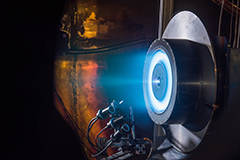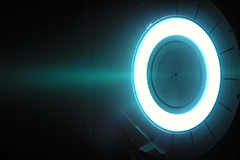Ion Thruster Engine
An ion thruster or ion drive is a form of electric propulsion used for spacecraft propulsion. It creates thrust by accelerating positive ions with electricity. The term refers strictly to gridded electrostatic ion thrusters, and is often incorrectly loosely applied to all electric propulsion systems including electromagnetic plasma thrusters.
 An ion thruster ionizes a neutral gas by extracting some electrons out of atoms, creating a cloud of positive ions. These thrusters rely mainly on electrostatics as ions are accelerated by the Coulomb force along an electric field. Temporarily stored electrons are finally reinjected by a neutralizer in the cloud of ions after it has passed through the electrostatic grid, so the gas becomes neutral again and can freely disperse in space without any further electrical interaction with the thruster. Electromagnetic thrusters on the contrary use the Lorentz force to accelerate all species (free electrons as well as positive and negative ions) in the same direction whatever their electric charge, and are specifically referred as plasma propulsion engines, where the electric field is not in the direction of the acceleration.
An ion thruster ionizes a neutral gas by extracting some electrons out of atoms, creating a cloud of positive ions. These thrusters rely mainly on electrostatics as ions are accelerated by the Coulomb force along an electric field. Temporarily stored electrons are finally reinjected by a neutralizer in the cloud of ions after it has passed through the electrostatic grid, so the gas becomes neutral again and can freely disperse in space without any further electrical interaction with the thruster. Electromagnetic thrusters on the contrary use the Lorentz force to accelerate all species (free electrons as well as positive and negative ions) in the same direction whatever their electric charge, and are specifically referred as plasma propulsion engines, where the electric field is not in the direction of the acceleration.
Ion thrusters in operational use have an input power need of 1–7 kW, exhaust velocity 20–50 km/s, thrust 25–250 millinewtons and efficiency 65–80% though experimental versions have achieved 100kW, 5N.
 The Deep Space 1 spacecraft, powered by an ion thruster, changed velocity by 4.3 km/s while consuming less than 74 kilograms of xenon. The Dawn spacecraft broke the record, with a velocity change of 10 km/s.
The Deep Space 1 spacecraft, powered by an ion thruster, changed velocity by 4.3 km/s while consuming less than 74 kilograms of xenon. The Dawn spacecraft broke the record, with a velocity change of 10 km/s.
Applications include control of the orientation and position of orbiting satellites (some satellites have dozens of low-power ion thrusters) and use as a main propulsion engine for low-mass robotic space vehicles (such as Deep Space 1 and Dawn).
Ion thrust engines are practical only in the vacuum of space and cannot take vehicles through the atmosphere because ion engines do not work in the presence of ions outside the engine. Additionally, the engine's minuscule thrust cannot overcome any significant air resistance. Spacecraft rely on conventional chemical rockets to initially reach orbit. More details
 An ion thruster ionizes a neutral gas by extracting some electrons out of atoms, creating a cloud of positive ions. These thrusters rely mainly on electrostatics as ions are accelerated by the Coulomb force along an electric field. Temporarily stored electrons are finally reinjected by a neutralizer in the cloud of ions after it has passed through the electrostatic grid, so the gas becomes neutral again and can freely disperse in space without any further electrical interaction with the thruster. Electromagnetic thrusters on the contrary use the Lorentz force to accelerate all species (free electrons as well as positive and negative ions) in the same direction whatever their electric charge, and are specifically referred as plasma propulsion engines, where the electric field is not in the direction of the acceleration.
An ion thruster ionizes a neutral gas by extracting some electrons out of atoms, creating a cloud of positive ions. These thrusters rely mainly on electrostatics as ions are accelerated by the Coulomb force along an electric field. Temporarily stored electrons are finally reinjected by a neutralizer in the cloud of ions after it has passed through the electrostatic grid, so the gas becomes neutral again and can freely disperse in space without any further electrical interaction with the thruster. Electromagnetic thrusters on the contrary use the Lorentz force to accelerate all species (free electrons as well as positive and negative ions) in the same direction whatever their electric charge, and are specifically referred as plasma propulsion engines, where the electric field is not in the direction of the acceleration.Ion thrusters in operational use have an input power need of 1–7 kW, exhaust velocity 20–50 km/s, thrust 25–250 millinewtons and efficiency 65–80% though experimental versions have achieved 100kW, 5N.
 The Deep Space 1 spacecraft, powered by an ion thruster, changed velocity by 4.3 km/s while consuming less than 74 kilograms of xenon. The Dawn spacecraft broke the record, with a velocity change of 10 km/s.
The Deep Space 1 spacecraft, powered by an ion thruster, changed velocity by 4.3 km/s while consuming less than 74 kilograms of xenon. The Dawn spacecraft broke the record, with a velocity change of 10 km/s.Applications include control of the orientation and position of orbiting satellites (some satellites have dozens of low-power ion thrusters) and use as a main propulsion engine for low-mass robotic space vehicles (such as Deep Space 1 and Dawn).
Ion thrust engines are practical only in the vacuum of space and cannot take vehicles through the atmosphere because ion engines do not work in the presence of ions outside the engine. Additionally, the engine's minuscule thrust cannot overcome any significant air resistance. Spacecraft rely on conventional chemical rockets to initially reach orbit. More details
